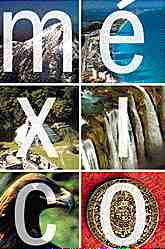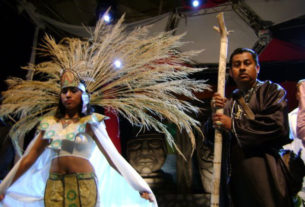February 1997
Oaxaca is called “Tierra del Sol,” and it a landscape blessed with a spring-like climate and plenty of sunshine. The city of Oaxaca is located in a picturesque valley with an altitude of 1,546 meters. Two chains of the Sierra Madre Occidental converge in the center of the state of Oaxaca, creating a fertile valley, that has attracted human occupation for thousands of years.
 The state tourism agency, SEDETUR, has created a division expressly for the promotion of nature-oriented tourism in the Central Valley. The name Tourist Yu’u is given to small tourist houses in nine Indian villages. Destinations include Benito Juarez in the northern Sierra, Teotitlan, Tlacolula de Matamoros, Quialana, Tlapazola, Santa Ana del Valle, Santa Cruz Papaluta, San Sebastian Abasolo and Hierve el Agua.
The state tourism agency, SEDETUR, has created a division expressly for the promotion of nature-oriented tourism in the Central Valley. The name Tourist Yu’u is given to small tourist houses in nine Indian villages. Destinations include Benito Juarez in the northern Sierra, Teotitlan, Tlacolula de Matamoros, Quialana, Tlapazola, Santa Ana del Valle, Santa Cruz Papaluta, San Sebastian Abasolo and Hierve el Agua.
Visitors are encouraged to explore these areas by traveling on foot or bicycle or on horseback.
Each of these areas have been severely deforested, and have suffered varying forms of environmental deterioration. Officials from SEDETUR hope that the promotion of tourism can assist in the respect of local traditions and environmental improvement. In addition, a goal of that project is that each house has a its own nursery, raising trees which will help reforest the valley. An orchard near the Santa Ana house is already well underway.
The costs are low – 30 pesos per person per night, 100 pesos per family, and 10 pesos for camping. For foreigners, the biggest obstacle will be locating the houses. The maps are rather sketchy, so make sure you get good directions from the office in downtown Oaxaca. Contact SEDETUR at Independencia 607; Phone: (951) 60123, 64828 and 15040; Fax: (951) 60984.
Tourist Yu’u Destinations:
Two hours away from Oaxaca lies one of the most unique rock formations in Southern Mexico.
About 2400 years ago, nomadic people discovered Hierve el Agua and its springs, which were easy to direct and they used to irrigate their crops. A network of canals fed through terraced crops over half a square kilometer. Wells were constructed about ever 3.24 meters along the canals, and research dates the construction from 420-310 B.C. to 1500 A.D. The calcium carbonate and magnesium content of the water was so high that the deposits have literally petrified the canals.
Even now the spring produces two liters of water a second during the summer months. The water continues to flow through part of the ancient canal system.
For visitors, Hierve el Agua is one of the most popular attractions in the Central Valley. The Tourist Yu’u facility boasts several guest houses as well as a thermal swimming pool with mud, famed for their cosmetic properties.
Numerous comedores are installed and visitors can purchase local art made with palm leaves. This is a clean, well-managed area with well-tended bathrooms.
How to get there: the turn off is after the road to Mitla. Then trip up into deforested and forested hills and then a well-marked turn-off. The final stretch leads through narrow streets of a San Lorenzo Albarradas, a small community. You’ll wind through an agricultural terrain where the fences are made of stone or cactus and locals dry their surplus corn on the roofs of their houses. El Tlacolula is the central town in the Tlacolula Valley. The town is home to more than 10,000 people. The Sunday market, reported to be one of the oldest in all of Mesoamerica, is the largest in the area. The valley is home to more than 60,000 Indians who speak the Zapotec language. There are numerous colonial buildings.
San Bartolome Quialana is a small community of 2,500 people. The villagers make nets from the fibers of the agave. they also make black and white woolen blankets.
Santa Ana del Valle is downhill from Quialana. The villagers earn their living from agriculture and from weaving. The town has a museum with various archaeological objects as well as examples of weaving techniques and natural dyes.
San Marcos Tlapazola is a village of 1,500 people, though many of the men have emigrated to the United States to work as farm workers. the women started a cooperative to make clay pots. The Tourist Yu’u has an excellent location outside of the town and overlooks the fields of agave plants.
San Sebastian Abasolo is a farming community of 1,700 people. It is a relatively prosperous village. The fields surrounding the town produce three crops (corn, garlic and chiles) each year, depending on the season. The region’s high water table allows for irrigation.
Santa Cruz Papalutla is about the same size as Abasolo. Residents make baskets from carrizo. The Tourist Yu’u here has a butterfly design to honor the town, whose name means “field full of butterflies.”
Teotilan del Valle is world-famous for its traditional weaving of woolen blankets. Natural dyes are being slowly being replaced by artificial colors. The traditional cochineal bug which produces a somber red is very expensive, and consumers have asked for brighter colors which the squashed bug just does not provide. In recent years, weavers have begun to create rug versions of paintings by Picasso, Matisse and Diego Rivera. If you have the time, you can even bring a photograph which will be converted into a pattern.
Benito Juarez is a mountain community and the only location of a Tourist Yu’u that is not in the Central Valley. The town has a small garden as well as a health clinic with examples of curative plants. A 30-minute walk takes you to El Mirador, which offers a view of the Oaxaca Valley and a glimpse of Pico de Orizaba.

